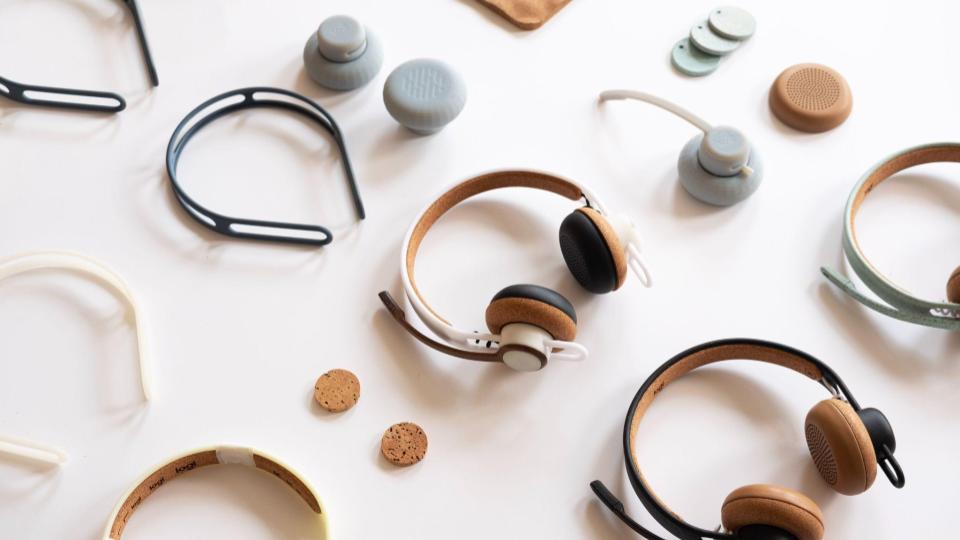Beyond Plastic: Logitech's Innovation Approach to Alternative Materials
NORTHAMPTON, MA / ACCESSWIRE / April 22, 2024 / Logitech
Logitech Blog
Kicking off with Earth Day, this first article in a three-part series invites readers to learn how Logitech's design innovation culture is pushing next-level solutions with Design for Sustainability.

Designing for sustainability in consumer electronics
Setting the stage for breakthrough innovation takes more than a commitment to delivering next-level ideas. It lives deep within the company culture and starts with fostering a workplace environment that both encourages the unreasonable and nourishes employee confidence to iterate and learn through failures.
This innovation story began with an idea to keep Logitech's youngest user safe and engaged. Safe for kids and safe from kids. The concept was to introduce a product made with materials to be proud of, be loud about, and love. One with the potential for materials to be circular, renewable, biodegradable, or possibly even a carbon sink.
Cork
More than a trendy material, cork has the potential to be an alternative to plastic in everyday life. It's a natural material well known for being very lightweight, naturally heat resistant, and impermeable to liquids and gasses. It's a favorite material for manufacturers and designers to explore. It's no wonder Logitech's design, engineering, and materials innovation teams jumped at the opportunity to think unconventionally about it.
Logitech's focus is to design smarter with less environmental impact. It embeds Design for Sustainability (DfS) capabilities throughout all aspects of its design-led manufacturing process, including prototyping with materials that reduce environmental impact. Its goal is to transcend current solutions that not only redefine new aesthetics for consumer desirability but also create a vision for the future without the use of hidden impacts.
Every project at Logitech entails research, experimenting, and physical prototyping to evaluate the benefits for People, Planet, and Brand. The idea to prototype a cork headset was chosen to learn about manufacturing challenges and scalability, less about trying to deliver a cork-based product.
Not only is cork naturally durable, but in its natural form it has a lower carbon impact per gram of material than many other rubber and plastic material options currently used in electronic devices. However, cork cannot be manufactured using a typical process of injection molding, so the team looked at two possible routes.
First, it could be pressed into shapes using compressed cork to replace large plastic parts. Second, the team experimented with mixing cork and plastic together to create a cork composite that could be injection molded.
Based on preliminary DfS insights, compressed cork provided an excellent opportunity to add to its growing list of lower-carbon impact materials. However, cork composites (cork mixed with plastic) were trickier to establish insights. Interestingly, compressed cork and cork composite boasted a comparable low carbon footprint to the recycled plastic currently used in Logitech products - but cork composites are not widely recycled at the end of their life. Combining a natural material such as cork with conventional plastics poses challenges for recyclers, hindering the reuse of these materials. An effective approach to this challenge could involve setting up a closed-loop recycling system under Logitech's direct management. Picture the possibilities of a future where we utilize lower-impact materials and contribute to achieving our Circularity goals.
Proof of concepts emerged for a headset, a mouse, a tablet case, and a stylus. The cork headset prototype allowed the collaborative design, engineering, and materials teams to envision, learn, and vet materials beyond the traditional foam, plastic, and rubber. "The headset was a catalyst to inspire and create conversations around radical thinking," said Jasper Phua, Head of Global CMF at Logitech. "Projects like this challenge Logitech to leapfrog on sustainability innovation because not only are they exciting to work on, but they inspire us to act on differentiating ourselves in the marketplace." The teams are enthusiastic to see what the future holds for the adoption of compressed cork.
Alternatives to virgin plastic
Setting cork aside, what is sitting at the heart of materials innovation? Plastic. Almost 400 million metric tons of plastic was produced globally in 2021, doubling since the beginning of the century. Although the average lifespan of a plastic product is around 10 years, its composition and disposal can take up to 500 years to decompose. That means your grandchildren's grandchildren would be able to drink from the plastic cup that was thrown into the trash today. It's time to change how we produce, consume, and dispose of plastic. Alternative materials hold the key to creating this shift.
Post-consumer recycled plastic is material made from items that people recycle every day. It's still plastic, but it's one of the critical pathways to reducing the environmental impact of plastic products and the pollution it generates. More importantly, recycled plastic is a proven, scalable solution to reducing carbon impact in products made with plastic. The trick is getting the plastic back into the system. In the US, only 5
Logitech calls post-consumer recycled plastic Next Life plastic because it has been given a second life. Nearly 2 in 3 Logitech products use Next Life plastic across the portfolio. Not only does Next Life plastic have a lower carbon footprint compared to virgin plastic because it requires less water, fossil fuels, and energy to produce, but it is also an essential component of the circular economy. Leveraging and expanding the use of Next Life plastic across a variety of products is only the beginning. Because of Logitech's persistence in innovating with Next Life plastic, there is an array of mice, keyboards, and webcam options in over 40 exciting colors. Having the option to choose from vibrant colors beyond grey or black mice and keyboards allows everyone to express their personality.
Eliminating single-use plastic
Several years ago, Logitech formalized a commitment to reducing and eliminating as much single-use plastic as possible and began to transition packaging to paper-based alternatives, expanding its FSC-certified packaging program. When the Aurora Collection launched, packaging for the G735 headset used a molded paper pulp tray, a wood fiber tissue wrap, and a paper pulp hang-tab eliminating the need to use plastic labels, plastic hang-tabs, and single-use plastic bags. More than
We all have a role to play
Next time you're considering a purchase, shop sustainably. Choose products made with recycled plastic when you have the option or choose not to purchase plastic entirely. Let's take broader steps to turn off the tap on plastic pollution. It's time for everyone (including businesses) to know our impact and take action. We all hold the power to drive change. Here are simple steps you can take to tackle excess plastic.
- Choose reusable options. Carry your own water bottle.
- Recycle your plastic in curbside bins and bring end-of-life electronic devices to proper recycling centers.
- Be an advocate for change and ask local suppliers or restaurants to ditch the plastic.
- Join a beach clean-up or pick up plastic trash in your neighborhood.
- Look for products made with alternative or renewable materials like paper and cork.
View additional multimedia and more ESG storytelling from Logitech on 3blmedia.com.
Contact Info:
Spokesperson: Logitech
Website: https://www.3blmedia.com/profiles/logitech
Email: info@3blmedia.com
SOURCE: Logitech
View the original press release on accesswire.com







